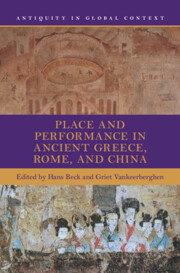Book contents
- Place and Performance in Ancient Greece, Rome, and China
- Antiquity in Global Context
- Place and Performance in Ancient Greece, Rome, and China
- Copyright page
- Contents
- Figures
- Tables
- Contributors
- Series Editors’ Preface
- Editors’ Preface
- Introduction
- Part I Crafting Space and Place
- Part II Performances of Power
- Chapter 3 Power and Its Trappings in the Han and Roman Bureaucracies
- Chapter 4 The ‘Performance’ of Agricultural Labour in Ancient Rome and Han China
- Chapter 5 Foreigners, Spectacles, and Imperial Performance
- Chapter 6 The Maiden and the Mirror
- Part III Urban Places
- Part IV Fringe Places and Endpoints
- Index
- References
Chapter 4 - The ‘Performance’ of Agricultural Labour in Ancient Rome and Han China
from Part II - Performances of Power
Published online by Cambridge University Press: 28 November 2024
- Place and Performance in Ancient Greece, Rome, and China
- Antiquity in Global Context
- Place and Performance in Ancient Greece, Rome, and China
- Copyright page
- Contents
- Figures
- Tables
- Contributors
- Series Editors’ Preface
- Editors’ Preface
- Introduction
- Part I Crafting Space and Place
- Part II Performances of Power
- Chapter 3 Power and Its Trappings in the Han and Roman Bureaucracies
- Chapter 4 The ‘Performance’ of Agricultural Labour in Ancient Rome and Han China
- Chapter 5 Foreigners, Spectacles, and Imperial Performance
- Chapter 6 The Maiden and the Mirror
- Part III Urban Places
- Part IV Fringe Places and Endpoints
- Index
- References
Summary
The second chapter in Part II (‘Performances of Power’) turns to a performative arena that is both fundamental to pre-modern societies and yet often forgotten – and that is particularly instructive for cross-cultural comparison. Darian Marie Totten discusses the organization of agricultural labour, not from an economic standpoint but with regards to its innate capacity to govern quotidian experience, endorse ideas of equality and inequality, and structure society. A similar avenue of inquiry is prevalent in Ryan R. Abrecht’s contribution on neighborhood encounters and the rhythm of social life (Chapter 7). In Totten’s take, labour, performed on elite estates and overseen by a court that claims ultimate superiority in knowledge and organizational skill, lies at the heart of social hierarchy and imperial statecraft. Building off theories of performance, the chapter first unravels the basic nexus of social reproduction and discrete agricultural activities – the communication of knowledge, its cyclical application and transmission into a structured workflow, among others. Resonance with real life, inevitably so, shapes and defines different social strata that are discussed in the chapter’s main section: the imperial court and elite landowners, estate managers, free and unfree tenants, and/or slaves. For each of these, Totten displays an ingenious investigative sense that makes voices heard and explores agencies, privileged and underprivileged alike. The bulk of evidence for the comparative study of context in Han China and the Roman Empire is of a literary nature, the Book of Han the Book of Later Han, Monthly Ordinances of the Four Seasons and the agricultural writings of Cato, Columella, and Varro, which figure prominently throughout. At the same time, Totten draws on the visual language of coinage, mosaics, and murals that signalled a forceful message to their ancient audiences: that agricultural performance was critical to the creation of the social cohesion around them. In conclusion, the chapter places its findings into communications between imperial ideology and its translation into the local horizon. Han Chinese and Roman culture relied heavily on agrarian activity, both economically and performatively. While both established similar practices in the amassing of resources, the performance of agricultural labour, argues Totten, followed rather divergent trajectories, with profound ramifications for the experience of empire.
Keywords
- Type
- Chapter
- Information
- Place and Performance in Ancient Greece, Rome, and China , pp. 114 - 160Publisher: Cambridge University PressPrint publication year: 2024

